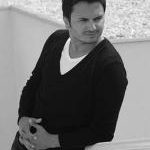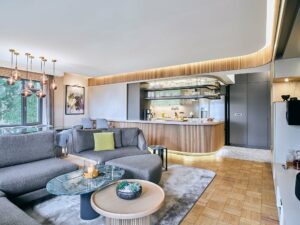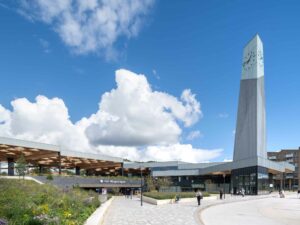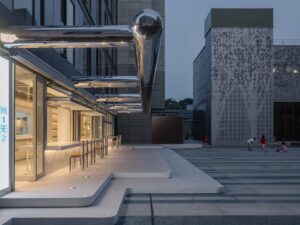- 9 Mart 2017
- 3101 defa okundu.
Katılımcı, Bandırma Tasarım Parkı Yarışması
Mimari proje raporu (İngilizce):
A NEW PARK FOR THE FUTURE OF THE CITY
The city is a commercial centre and its harbour serves as a transit point for trade between Istanbul and İzmir. The city has road and rail connections with other urban centres. Bandırma is 90 km away from Balıkesir, and located in 100 km northeast of Istanbul (by boat), 100 km east of Bursa, 270 km southwest of İzmir and 170 km west of Çanakkale.
Nowadays the city is re-planned according to the new integrative vision shaped by the current state of industrial-tourism-agricultural-transportation sectors and the advantages of its geographical position. Adding to that, the city is located only a few steps away from 72 universities and thousands of students of surrounding cities.
HISTORY
If we look at Bandırma’ s history it is thought to have been established between B.C. VIII-X centuries. Bandırma was initially within the borders of the Mysia region. In these years, the name was Panormos, meaning “reliable port”.
The area was conquered by the Ottoman Empire from the Byzantine Empire in the 14th century.
The town, once known as Panderma, grew with the opening of the Izmir Railway in 1912. The port was active, and hosted steamships from throughout the world, including British and Greek ships. Larger docks for large steamships had been intended to be built in the city.
Bandırma, which was an export port city before the Republic of Turkey, has continued to increase its feature of being an export port and one of the important transportation centers of Turkey in the Republican period with the construction of the port, the increase of urbanization, Bandırma-İzmir railway line and Bandırma-İstanbul ferry transportation.
IDENTITY AND CONCEPT
The Bandırma Park Project should be a place which reflects the story of the city to the new generations and the old ones as well. The story of the city is its being a port city since its existence. Establishing the identity of the project site as being a port city, has a strong response in both local and universal collective memory.
As a result of this idea, here we treat the project area as an urban port. The main point is the inspiring mechanism of a real port with the mobility, flexibility, and the dynamism in itself ; the proxy beings of the spaces/volumes. So here we use this port architecture fiction in our concept which will correspond to another time interval. In our proposal, people are going to use the architectural spaces/buildings for decades for a limited time but they will use the park/forest functions forever. In the beginning, all the building functions of the project site will coexist with the forest life and the park life. As the time passes, here we will see the benefits of the port architecture concept and leave all the project site to the urban forest and urban park in the city center and settle our buildings in another area.
CONTAINER ARCHITECTURE
The use of containers as a building material has grown in popularity over the past several years due to their inherent strength, wide availability, and relatively low expense.
Strength and durability
Shipping containers are in many ways ideal building materials. They are designed to carry heavy loads and to be stacked in high columns. They are also designed to resist harsh environments, such as on ocean-going vessels or sprayed with road salt while transported on roads. Due to their high strength, containers may be adapted for secure storage.
Modular
All shipping containers are in the same width and most have two standard height and length measurements and as such they provide modular elements that can be combined into larger structures. This simplifies design, planning and transport. As they are already designed to interlock for the ease of mobility during transportation, structural construction is completed by simply emplacing them. Due to the containers’ modular design, additional construction is as easy as stacking more containers. They can be stacked up to 12 units high when empty.
Labor
The welding and cutting of steel is considered to be specialized labor and can increase construction expenses, yet overall it is still lower than conventional construction. Unlike wood frame construction, attachments must be welded or drilled to the outer skin, which is more time consuming and requires different job site equipment.
Transport
Pre-fabricated modules can also be easily transported by ship, truck, or rail, because they already conform to standard shipping sizes.
Availability
Used shipping containers are available across the globe.
Expense
Many used containers are available at an amount that is low compared to a finished structure built by other labor-intensive means such as bricks and mortar — which also require much more expensive foundations.
Foundations
Containers are designed to be supported by their four corners making a very simple foundation possible. Also, the top four corners are very strong as they are intended to support a stack of other containers.
Eco-Friendly
A 40ft shipping container weights over 3,500KG. During the upcycling of shipping containers, thousands of kilograms of steel are saved. In addition, when containers are used in building, the amount of traditional building materials needed (i.e. bricks and cement) is reduced.
PROJECT SETTLEMENT DECISIONS AND STRATEGY
RETAIL
According to our proposal’ s human scale and fragmented concept, the retail functions starts with the entrance square on the east side of the area which faces the city center axis that is within a walking distance. Related to the square, there is also a suggested tramway line/stop that is connected with the city center, Bandırma port and the pedestrian sea side road and park.
Unlike the classical shopping mall scheme, we decided to create a shopping street that is similar with the local shopping culture and scale. The people reach the other facilities of the park/forest through this human scaled shopping street. There are additional secondary streets that combine the shopping street to the forest which stands on the south side of the project area and the sea side standing on the north side of the project area.
DESIGN INSTITUTE
As we come along to the west side of the site, the historic buildings welcome us which give the clue that we get closer to the design institute. Some of the functions of the institute are penetrated in to the historical buildings according to their areas and the attention paid to the existing trees and plants. Here we use the same shipping container modules to build our own spaces. The modules which are placed in the heritage zone are pulled off from the ground and also from the walls of the existing buildings. The main thought in this intervention is the coexistence of the old and the new; without an identity problem; without complexity and contradiction.
In the south side of the heritage (buildings), some of the other functions of the design institute are put facing the spine axis between the old buildings and the new ones in an inspirational way that the old buildings settle down.
FOUR STAR HOTEL
It is known that the area had been used as a military storage for around 40 years, and was abandoned in the early 2000s. After the abandonment, there are still some concrete blocks on the ground. In accordance with our concept, we decided to use these separated concrete blocks as the ground for our bungalows’ foundations. By doing this settlement method (settling the container-bungalows to the existing concrete plates), we tried to give no extra harm to the land itself. As it is a soft touch for building a huge complex in the nature; it (bungalow accommodation) also serves better to the students/student lifestyles all around and students coming from other cities with both ideological and economical differences
FIVE STAR HOTEL AND CONVENTION CENTER
At the end of the main pedestrian axis, a five-star hotel and convention center is situated. It has a more private usage than the other facilities in the complex, so it is located to the left upper side. There is a car entrance from the east side of the site from the main road for the hotel users and the convention center users as well. The same container-architecture language is used to design the hotel and the convention center in a more prestigious way as desired in the competition book.
LANDSCAPE DESIGN PRINCIPLES
The Landscape vision for the Bandırma Park is to create an ecological, sustainable, quality green open space and urban forest for Bandırma. The integration of the park in the urban context is of critical importance. The park’s permeability towards adjacent neighborhoods emphasizes the intimate city-port-park relationship.
The vital elements to shape the landscape at the park are topography, climate and flora. It is aimed to create a rich landscape experience which varies from open meadows to dense forests, from herbaceous plants to wetlands. Therefore, biotopes which are attributed to natural landscape formation are formed.
GENERAL APPROACHES AND SUGGESTIONS
The park is built in a way that it provides uninterrupted pedestrian connection to all buildings, recreation areas, forests and their surroundings. The suggested pedestrian crossings and bike lanes are designed in an interconnected way. There are squares in the intersections of pedestrian roads in different sizes. Bike rental and bike parking areas are built at the entrance of the park; thus, the use of vehicles is minimized except for the service lanes.
Within the Culture and Activity Region, a flexible area is created for open air fests, concerts and other performances. The region will provide continuity by connecting the area in the north-south direction.
There are open air sports fields and playgrounds within the Sports and Playing Corridor. Following the principle of “Learning from the nature”, ecological and natural substances will be used in the playground areas. Sports fields are connected to the wetland region in the south.
A biological pond and a reed field is formed in the wetland area. Considering the Manyas Lake view in the vicinity, some wooden docks and observation towers are built on the pond. The pond is expected to create its own ecosystem in time and supposed to become a popular spot for the birds during the migration periods.
The park is enriched with various art and cultural activity areas. Sculpture garden, reading gardens, relaxation garden, yoga and meditation garden, hammock area, rainwater storage gardens, water plant gardens are among these areas. In addition to these, children’s theatre, open air cinema and workshop areas are also located here.
The existing tree texture is planned to be focused on as a bright element of the park. This area which is in its natural state is protected and improved. The forest is planned to earn the status of “City Forest” by increasing the dominant cedar, pine and cypress trees in the area and a forest development zone is thus created.
Urban Furniture
Sustainability and ecological approach are the most defining elements of the project from the subscales to super scales. Being the important elements of the area close to the sea, winds and the Sun are leading components in the design of urban furniture. Lighting fields which are lit by wind power are built in the part of Culture and Activity meadow that interacts with the sea. Wind shelters are designed for the watching terraces which are close to sea view so that the visitors will not be affected by the winds. Solar energy is directly used for urban furniture. Rainwater will be stored through drainage canals and will be reused for the irrigation of the park.
Landscape
While designing the landscape, ground rates are balanced in terms of being open-close, shady-sunny, green-solid. The arrangements are all disability-friendly.
In addition to the rich vegetation, it is aimed to create a four-season park and minimize the negative effects the climate. The park is enriched with coastal and forest land plant communities. Some of the plants used in forestation are as follows: Cedrus libani, Cupresus sempervirens, Pinus pinea, Pinus brutia, Juniperus excelsa, Crataegus monogyna, Alnus glutonisa, Carpinus betulus, Tilia rubra, Acer campestre, Populus tremula, Rubus sp., Acer platanoides, Fraxinus oxycarpa, Platanus orientalis, Prunus amygdalus, Prunus institia, Quercus cerris, Salix caprea, Tamarix sp., Thymus sp.,Lavandula stoechas, Arbutus unedo, Spartium junceum. Cyperus longus, Rorippa sylvestre, Cirsium arvense, Mentha aquatica, Lythrum salicaria, Althaea officinalis, Solanum dulcamara, Ranunculus saniculifolius, Iris pseudocorus, Juncus sp., Typha sp., Pharagmites sp., Carex sp. are some of the plants used in the wetlands.






